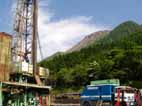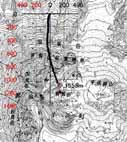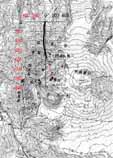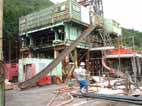[USDP-4 Daily Report] Sept-Nov., 2003
[USDP-4 Daily Report]
before April 10, 2003
July 5, 20041,
2,
3
1) The final core was recovered from the deepest level (1994-1995.75 m) on the morning of July 6. The appearance was similar to the conduit sample of 1975-1977 m, relatively fresh but mafic minerals are partly altered.
2) Temperature profiles with memory gauges produced in SANDIA suggest a peak between the 1950 and 1995 m depths.
3) Drilling head reached below just south of Mt. Fugen, passing through the conduit zone of volcano, between about 50 and 150 m below sea level (about 1.3-1.4 km below the crator). The latest conduit seems to be located at the southern part of the conduit zone.
Drilling operation was over on July 7.
July 4, 2004Cores of 1980.7-1984.2 m. Final core sampling is scheduled on July 6.
July 3, 2004Cores of 1977.4-1980.7 m. Samples are same as those of yesterday. Coring from the 1980.7 m depth was continued. Sidetrack drilling was chanceled due to new time schedule.
July 1, 20041
2
3
1) Cores of 1975-1977 m; reltively chilled (quenched), glassy part is in upper lines of this box (deeper depths) 2) Close-up view of fresh dacite, 3) Vertical taffisite veins in conduit lava. The chemical compostion of the conduit lava (65% SiO2) is very close to that of the 1991-95 dome lava. Coring was continued from the deepest depth (1977 m) and finishes on 6 June.
June 28, 20041
2
3
4
1) Cores of 1896-1902 m, 2-3) Night veiw of rig site, 4) Moon on the dome. Grains of clear glassy groundmass including microlites, clear plagioclase, and biotite were found in cuttings by tric-cone bit from the depth of 1975 m. Coring was decided on June 30 to take samples possible of new conduit.
June 27, 2004Cores of 1855.4-1856.7 m. Hydrothermally altered volcanic breccia with pyroclastic veins intruded probably horizontally. Temperature of well bottom still increases.
June 25, 20041
2
1: Temperature profile obtained after 97-hours standing time. Still temperature increases toward the bottom, suggesting the heat source (conduit of the latest eruption?) deeper than the well bottom.
2: Plain view of well trajectory, showing information on dikes and alteration.
Based on the temperature profile, continuation of drilling in the main hole was decided.
Temperature measurement was performed, following VSP. Side-track drilling will starts.June 23, 2004
First run of tough logging (TLC) was succeeded down to the bottom of the main hole (1799 m). Data of SP, resistivity, sonic, FMS (image), neutron and gamma-ray were gotten in the first run. The data suggest the existence of lava dikes (old conduits) from one of which core samples were taken on June 19.June 20, 2004
June 19, 20041
2
1: core 1792-1797.5 m, 2: core 1797.5-1800.8 m
1
2
3
1: Plain view of trajectory on June 19, and 2: vertical view. 3: logging preparation for 1550-1800 m on June 20.
Spot coring ended in the main hole on June 20. Following logging on June 21-23, side-tracking starts to take cores of conduit. New target will be set below the 1750 m depth.
June 17, 20041
2
1: Core of 1780-1782.8 m, 2: core bit
Core recovery was as low as 60%. Old conduit samples were recovered; a sheard zone developes inside the conduit; groundmass is hightly altered hydrothermally, though plagioclase phenocryst is survived from alteration.
Spot coring is scheduled tonight. followed by logging on Monday.
June 16, 20041
2
1: Core of 1754.3-1757.9 m, 2: core of 1757.9-1761.5 m
1
2
1: Rig in green on June 13, 2: on the early morning of June 17.
June 15, 2004Temperature profile with memory gauge, about 23 hours of standing time. Conduit is very close!
June 12, 20041
2
3
1: Spot cores of 1745-1749 m, 2: cores of 1750-1753 m, 3: close-up view of fresh glassy tuff vein in box 2! It is likely that this glassy tuff vein was intruded vertically (?) from the conduit in the latest eruption (1990-1995). Main part of the conduit is very close! Drilling with tricone bit will be done down to 1800 m after temperature measurement. Next spot coring is planned around 1800 m, which is followed by logging and VSP experiment and sidetracking.
1
2
3
1: Drilling trajectory (plain view), 2: vertical view, 3: temperature log. Drilling is being carried out beyond the primary target. Formation temperature is not very high.
June 11, 2004

Night view of rig (left, on the early morning of June 12) and 6-inch core barrels with inner tubes, used for coring presently (right).
1
2
3
1: Cores of 1700-1704 m.
2: Close-up view of cores (1700-1704) showing pyroclastic dikes of multiple scales.
3: Cores of 1704-1708.3.
Still high extent of hydrothermal alteration.
June 10, 20041
2
3
1: 1690-1694 m, 2: 1695-1698 m, 3: 1699-1700 m
Coring of 1690-1700 m (6.7 cm diameter) was done. Oxidized and partially hydrothermally altered porphyritic dacite (mainly consolidated volcanic breccia) was recovered continuously. The extent of hydrothermal alteration was lower than in the sample of 1584-1591 m. Thin veins of lava cutting volcanic breccia (dike-lets) are observed.
June 9, 2004Drilling down to 1690 m (only 10 m front of the planned target). Setting memory gauge to get a temperature profile around the target was tried before 2nd spot coring. The temperature profile was taken with standing time of 7 hours and 10 minutes. The present depth is still away from the target. Coring is conditued from this depth instead of spot coring.
Cores near the conduit region were recovered completely from the depth interval from 1584.3-1590.7 m on the afternoon of June 8.June 8, 2004



Example of recovered cores and close-up views of brecciated parts. Samples are dacite hydrothermally altered. Ash-filled veins are observed cutting brecciated parts.

Cuttings boad show the image of formation (800-1500 m).
June 7, 2004

Drilling trajectory (left) and temperature profile (right).
Spot coring of 8 m long was started from about 1580 m on the morning of June 8.
June 5, 20041
2
3
4
1: Drilling site seen from the lava dome top (summit) on June 2, by M. Nonaka
2: Close-up view of the above
3: Ring with the lava dome in background on June 3
4: Liner hanger used on the 7-inch casing set.
Casing (7-inch liner) was set successfully down to 1550 m depth. Drilling with 6-1/4 inch bit (final step) started to take core samples near and at the conduit!June 3, 2004
Tough Logging operation for the depth interval 800-1542 m (73-75 degree hole) was completed! Ten-m wide dyke probably of the feeder (conduit) of the 1792 eruption was detected.June 1, 2004
May 30, 2004

Tough logging (TLC) down to 1500 m started this day. Right: meeting of logging and drilling staff during operation of TLC.


Trajectory plain and vertical views.
May 28, 2004Temperatures of MWD (green) and mud circulation (gray: in and red:out) with lost circulation (blue)
Drilling operation advances much faster than the schedule shown in the drilling chart at bottom of this page (around 40 m a day).May 26, 2004
Casing pipes down to 1500+ m is inserted around May 3-5, following Tough Logging (820-1500 m) on May 31 and June 1.
Target (conduit) will be penetrated first probably in middle-June.
1: Drilling rate (ROP)1
2
3
2: Temperatures of MWD (green) and mud circulation (gray:in red:out) with lost circulation (blue)
3: Drag data (black: DHM drilling, orange: rotary mode, blue: up drag, red: down drag, green: torque)
May 24, 2004

Drilling trajectory plain (left) and vertical (right) views on May 26 morning.
Drilling advances about one week faster than schedule!
May 19, 2004Drilling trajectory plain view (left on May 24) and vertical vew (right on May 23).


May 18, 20041
2
3
4
1: TDS (Top-Drive System) installed
2: MWD (measurement-while drilling) tool before setting
3: MWD installed in non-magnetic drilling pipe just above DHM (down-hole-motor)
4: EM antenna of MWD set behinde MWD tool.
All taken on May 14, 2003
May 14, 2004A slide was set from rig floor to the ground for emergency during drilling conduit. Taken by S. Sakuma on May 16.


Pain (left) and vertical (right) veiws of drilling trajectory by this day. Red lines are scheduled trajectory. Small circles are daily advances.
Drilling operation began after a week preparation in the rig site and the temperature logging.
The target was shifted according to the newest results of geodetic and seismological data. The previous target depending largely on the seismic tomography. However, we determined the taget a littel east from the previous one, as shown below.
1
2
3
Figure 1. Tragectory in plain view of the summit area.
Figure 2. Vertical cross section showing the new target.
Figure 3. Drilling plan for the 2004 fiscal year, starting in May.